My digital camera tends to accompany me on journeys beyond the Hedgerow. This page contains pictures from those journeys.
25th May
The Hair Cap moss grows alongside heathers in the forestry - one of my candidates for next years website.
31st May
I spied this Early Purple Orchid at the side of a main road. I had to dodge the traffic to get it.
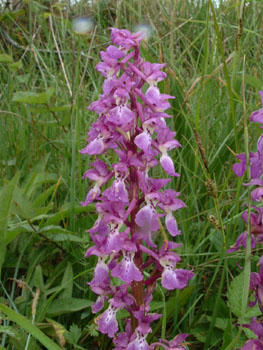
16th June
I am really surprised that I don't have the Ox-Eye on the hedgerow:-
Here is another flower I would have expected on the Hedgerow - the Hop Trefoil. This is about 1 mile away.
2nd July
Today my main walk was hijacked due to a burst water main, so I drove to a hill-top about 2 miles away. It was a rather fruitful decision.
This is the Greater Spearwort:
And this is yet another Speedwell - the Heath Speedwell:
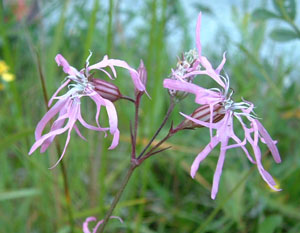 I
always think the Ragged Robin looks rather exotic.
I
always think the Ragged Robin looks rather exotic.
The Cross Leaved Heath is a member of the Heather family
I'll need to get a better photo of this Yellow Rattle
tomorrow
4th July
The Yellow Flag Iris really brightens up the roadside at this time of year:
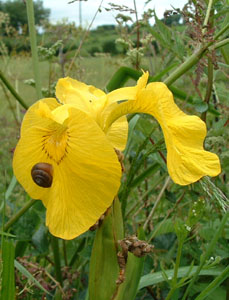
5th July
Quite a few firsts for me today: These photos were taken in a very marshy area at the top of our local hill, Mongorrey. Until recently, the area was deeply forested. The harvest has left the area very open and much brighter than previously.
This is the
Bell Heather - a very attractive colour
This Common Centaury should flower tomorrow. Another nice colour.
I suspected there were insectivorous plants around this area. This is the Common Butterwort, which catches insects on its sticky leaves.
This is the Heath Milkwort:
This is a
Water Forget-me-not. It was growing in a stagnant pool.
This is the Fairy or Purging Flax. It used to be used as a
purgative.
6th July
The powdered root of the Blue Comfrey was once used to make
casts for broken limbs.
8th July
This is the New Zealand Willowherb - an escape that now lives high in the hilltops. There's now a better photo on the main July page.
And this is the Square Stalked Willowherb. It can only really be identified by the use of a magnifying glass to look at the hairs on the stem and/or calyx, although the closely pressed leaves are a good indicator.
There is an Irish Eyebright which is rather more purple than the usual white Eyebright that I see around here. These two were growing a few inches from each other. I'm not sure if the one on the left is the Irish, or just a more purple version of the 'normal' white.
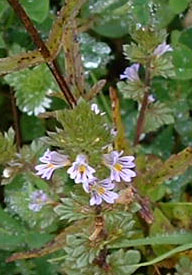
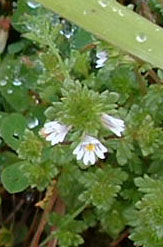
10th July
This very robust spotted orchid is probably a hybrid between Northern Marsh Orchid and Common Spotted Orchid, both of which were growing nearby.
Here's some purple heather
And that's the side view of a tiny (3mm) Forget-Me-Not. Notice the pink colour of the ones on the right hand side.
12th July
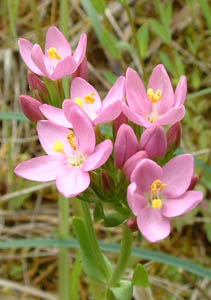 This
is the first flowering plant of Common Centaury that I've seen....Beautiful
colour.
This
is the first flowering plant of Common Centaury that I've seen....Beautiful
colour.
14th July
Two invaders, side by side.
The Himalayan Balsam on the left is growing on many grass verges around here, making large swathes of pink by the roadside. The other (as yet unidentified) is also common where there is some moisture.
17th July
This is the Marsh Willowherb. Notice the very narrow leaves and the overall greyish appearance.
19th July
I knew it was up the hill, somewhere. This is the Sundew, which catches insects on the sticky parts of its leaves. The photo on the right is a close-up of one leaf. I'll show the flowers when the buds open.
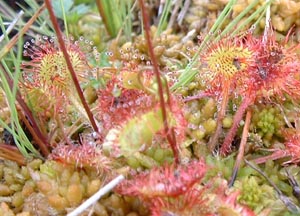
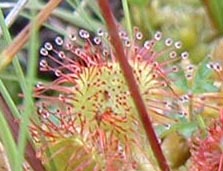
And this is the Bog Asphodel. It grows in bogs, just beside the Sundew.
25th July
The following three images show how fast the floral landscape changes. Last week, none of these plants were obvious. From left to right, we have:
Red Rattle, Devil's Bit Scabious and Knotted Pearlwort
28th July
Here's another look at some Sundew.
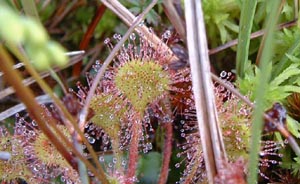
23rd August
Today, I stopped on a newish bypass that cut through what had been farmland until last year.
When it's
wet, the seedhead of the Wild Carrot adopts the shape of a bird's nest.
Yarrow is usually white, and occasionally pink, but this example was a strong purple.
This picture is what I call a "toofer": Two for the price of one. A Corn Marigold plus the seedhead of the Poppy.
And talking of Poppies:
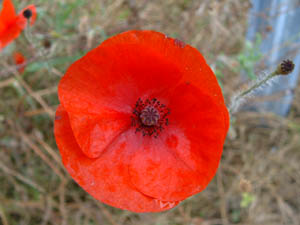
I think this is an ugly plant with a silly name: Fat Hen.
Apparently, the name is derived from its use for feeding chickens.
Finally, the Red Campion:
2nd October
Yet more fungi, The first photo shows how prolific the fungi have been this year. Three species in a 20 cm area. The one on the left has a distinctive red stem.
The one on the left was about 1 cm across - very delicate, growing on moss. The one on the right looks like it's a Peziza.
3rd October
A fine example of a Perennial Sow Thistle. It's worth 3 views - flower face, flower side and seedhead.
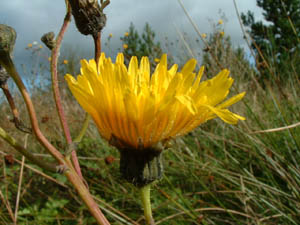
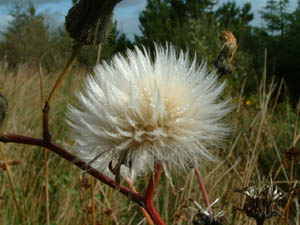
You have also now discovered how I keep plants from moving on gusty days.
19th October
Another example of how late some plants are this year - the Ragged Robin.
And this is a (not great) picture of the Lesser Spearwort. It flowered in May and then disappeared for several months.

The Ox-eye Daisy has been in flower - more or less - for 6 months, now.
Finally, the Lesser Yellow Trefoil is back, again.
28th October
There are a couple of these Sweet Chestnuts growing behind the Beeches. They must have been planted with the plantation conifers, around 50 years ago. I'd say they are around 35 to 40 feet tall.